When looking at your Dynamics CRM system, you may start to wonder, "Where do I store the documents I want to associate with a specific record?" Natively, CRM systems are not designed to store or manage documents. Attaching documents to your "Notes" in a specific record is traditionally how most people would save documents in Dynamics CRM, however, this takes up storage space and can add additional expenses if you ever need to upgrade. It also lacks some of the document management requirements people have and want in their organization. There are a lot of ways that SharePoint and CRM can complement each other with their features, however, the built-in integration between the two is focused on storing and managing documents in SharePoint document libraries and ultimately then surfacing these in the context of a CRM record.
Here are some of the advantages of integrating SharePoint with Dynamics CRM:
- SharePoint storage: 10 GB standard ($.20 per GB extra)
- Dynamics CRM storage: 5 GB Standard ($10 per GB extra)
- Receive collaboration for non CRM users within your organization or share documents externally
- Enable use of SharePoint document manager features like check out/check in and version history
- Provides the interface to support OneNote integration with CRM
- SharePoint can sync to your Desktop Library and Outlook
- Integrate SharePoint with Microsoft Delve for advanced searching functionality through your document library and documents
For Dynamics CRM Online and SharePoint Online users, it is recommended that you use the Server Side integration. This is a one-time process. Here are the instructions for setting up the Server-Based SharePoint Integration in Dynamics CRM.
As you read through these instructions, you might find that you need a little more clarification on step 7 in the set up process. Let's dive deeper!
You have two folder structure options you can choose that your organization will leverage when uploading new or extracting existing documents. The first is Account or Contact centric. The second is entity folder structure centric. The diagram below displays the differences. The Account and Contact centric option is for organizations that choose Accounts or Contacts to be their primary entity. The related entities would be Opportunities, Quote, Cases, etc. When a document is saved to any of the related entities, that document will map back to the primary Account or Contact record, depending on which option you choose.
For example, say David is the manager of the Inside Sales team, while Kyle is part of the Inside Sales team. Kyle has three open Opportunities he is working on closing with PowerObjects as the Account. Kyle receives a signed agreement for Opportunity #2 and saves that agreement to the Opportunity #2 documents section in Dynamics CRM, which is really saving the document in SharePoint because Dynamics CRM is just providing an interface to SharePoint. David receives an email letting him know he needs to approve the signed agreement before the Opportunity can close. David goes into the PowerObjects account in Dynamics CRM and looks at the saved documents related to PowerObjects. There he finds the signed agreement for Opportunity #2, he reviews and approves to close the Opportunity. He can do this because when enabling the Dynamics CRM integration with SharePoint, the Accounts centric folder structure was selected. As a result, Kyle was able to save a document to an Opportunity and David was able to see that document in the Account because the Opportunity #2 Kyle was an Opportunity related to the PowerObjects Account. Easy!
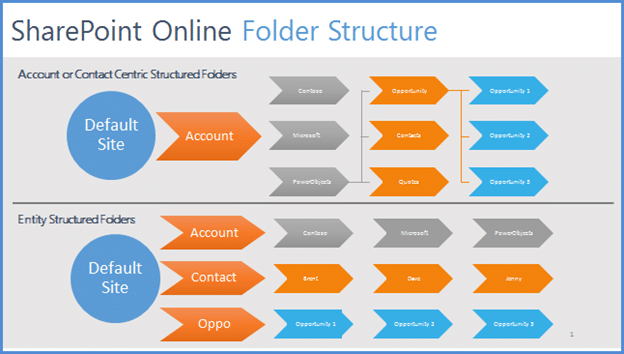
Once you have your Dynamics CRM integration with SharePoint enabled, simply navigate to any record in Dynamics CRM and navigate to Documents. Once you open the documents it will prompt you to create a folder. The integration will create a new folder in SharePoint using the name of the record and adding its own GUID to display the folder name. You need to Confirm to create the folder.
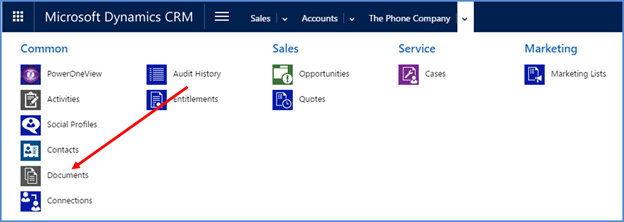
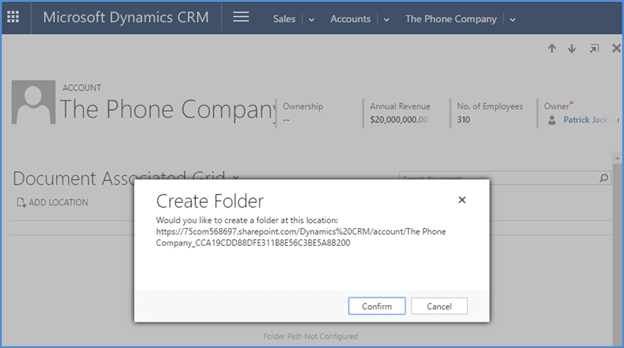
Now that you have the integration enabled and you have created a folder in SharePoint, you can start working with documents both in Dynamics CRM and SharePoint. In the document section of Dynamics CRM, you'll see a grid presented. There are commands for Upload, Checkout, and Check-in. You can also create new document using Microsoft Office Online.
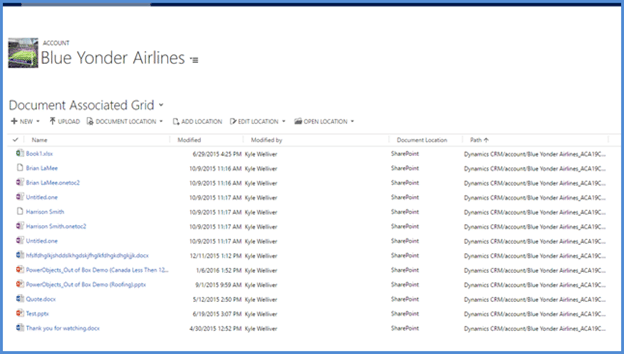
Items you won't see in the grid are Alert Me, Version History, View Short Cut, and Download a Copy. Because you have enabled using server side sync, it doesn't have those same additional options, but you can get to all the different options by using the open SharePoint command. Open SharePoint takes you to the SharePoint folder in the native SharePoint interface, giving you full capabilities that SharePoint offers on the individual document.
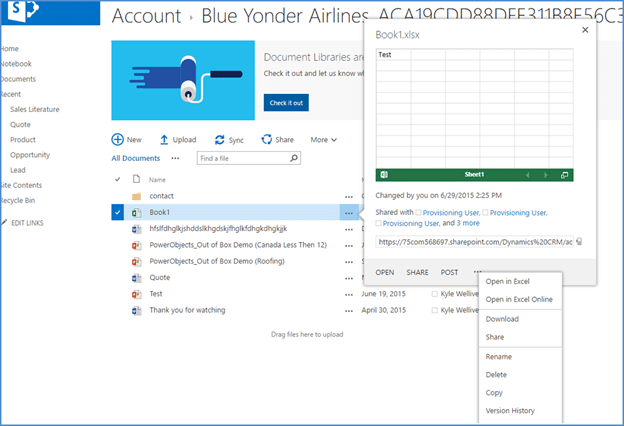
Subfolders will not be displayed in the Dynamics CRM grid, but all of your documents will be displayed. You can still set up your folder or subfolder hierarchy in SharePoint. You can see the folder location through the Dynamics CRM grid. The folder location lets you see whether the document was saved to the record you are on, saved to a folder created in SharePoint, or saved to a related entity, like the scenario where Kyle saved a document to an Opportunity and David was able to see that document saved in the Account.
You can create views based on your folders. For example, you can have custom entities (like projects, which is a subfolder to the Account). So if your team calls all of these "project documents" and puts them in a project sub-folder, you could create a view that would filter on the location that contained the word "project" in it.
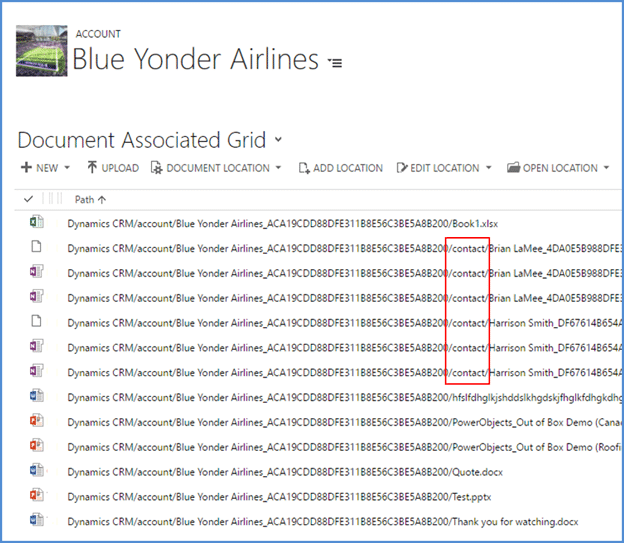
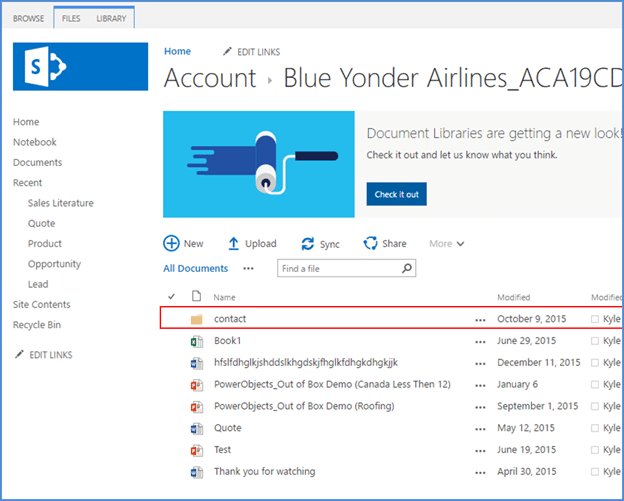
Here is a list of common questions we get after the SharePoint integration is enabled:
- Can you delete a document from within the context of CRM? Yes! It does delete that document in SharePoint as well.
- What if I delete the CRM record? This will not remove the SharePoint document library created.
- Can I merge records in CRM? Merging records will result in merging records having multiple locations.
- Can document locations be auto created when creating a new record in CRM? Document locations can be auto created via workflow or other custom code. Here is a blog that talks more about this: Bulk Creation of SharePoint Folders and Automated Integration with Dynamics CRM.
- I have SharePoint on-premises, can I connect my Dynamics CRM Online account with SharePoint on premises? Yes, use Client Side Sync with some additional configuration steps.
- Are security roles the same between Dynamics CRM and SharePoint? Dynamics CRM will have its own security settings around the SharePoint integrations (document locations, SharePoint site, etc.).
- I don't like the GUID and want to change the folder name after the folder is created. How do I do this? Changing the name of a folder after the folder was auto created through Dynamics CRM and has the GUID will error out the location in Dynamics CRM. There is a customization you can add that will auto create the folder names without the GUID.
That's all for the blog today! SharePoint is just one of many integrations for Dynamics CRM. Check out our free Webinar on Demand, Microsoft Dynamics CRM and Office 365: Introduction to Out-of-the-Box Integrations, to learn more!
Happy CRM'ing!
 How Microsoft Power Platform is helping to modernize and enable...
How Microsoft Power Platform is helping to modernize and enable... Deliver an Extraordinary Omnichannel Experience
Deliver an Extraordinary Omnichannel Experience Data Interoperability Key to Improving the Patient Experience
Data Interoperability Key to Improving the Patient Experience












Hi Joe,
Thanks for the article. Crisp and clear about CRM and SharePoint integration for document management.
You have mentioned "There is a customization you can add that will auto create the folder names without the GUID."
I am trying to find that customization but no success till now. Could you please suggest here? Basically, I want to get rid of GUIDs being used in the folder names for entity records in sharepoint. I know one method is to write a plug-in for that, but is there anything out of box?
Thanks and Regards,
Nirman Doshi
Hi Nirman,
Yep - there is a setting we can enable to remove the GUID. The setting is: CreateSPFoldersUsingNamesAndGUIDS
Use this tool to set it to 0 https://orgdborgsettings.codeplex.com/
Hi. Does this work in D365 or is there another fix to avoid getting the ugly GUID to the name when the folder is created?
Nope. Does not work in D365. Im also interested in a fix if you find one.
Joe,
Thank you so much for the article. I found it very very interesting.
You wrote in the questions above that we are able to delete a file within the CRM.
We just upgraded our CRM 2015 system to 2016 (both online) and the Delete button does not seem to work.
It doesn't do anything. (It did work before the upgrade)
Do you know if that's a known problem in CRM 2016 online?
Thank you so much!
Hadas
Hi Hadas - Does your delete button not show up or it does not do anything ? I just tested this on my test system and appears to work. Is you rcrm 2015 update 1.0 ?
When will users be able to upload documents through the CRM mobile app?
Nice write up Joe!
We have CRM2016 on premise with sharepoint online running for a few month and I notice it stopped created locations of related objects within Accounts location.
We have CRM setup for Account centric location which works for the default entities like incident. But for a managed entity PSA_Project, which has an Account field which links to an account, it doesn't create the entity folder within the account folder but directly in the Project location like Entity structured folders. Before with CRM2011 and client side plugin this worked fine.
Do you have an idea what CRM expects to know it should create the entity folder within the account folder?
Thanks
Bob
Hi Joe,
Thanks for the detailed post. I have integrated CRM and Sharepoint using these steps but its opening Sharepoint home page instead of folder page from CRM. Any idea?
Thanks a lot for the article Joe!!
After integrating Dynamics 365 CRM Online with Sharepoint Online, can we change the Sharepoint server account later? If yes, how can I do that?
Thanks in advance.. 🙂